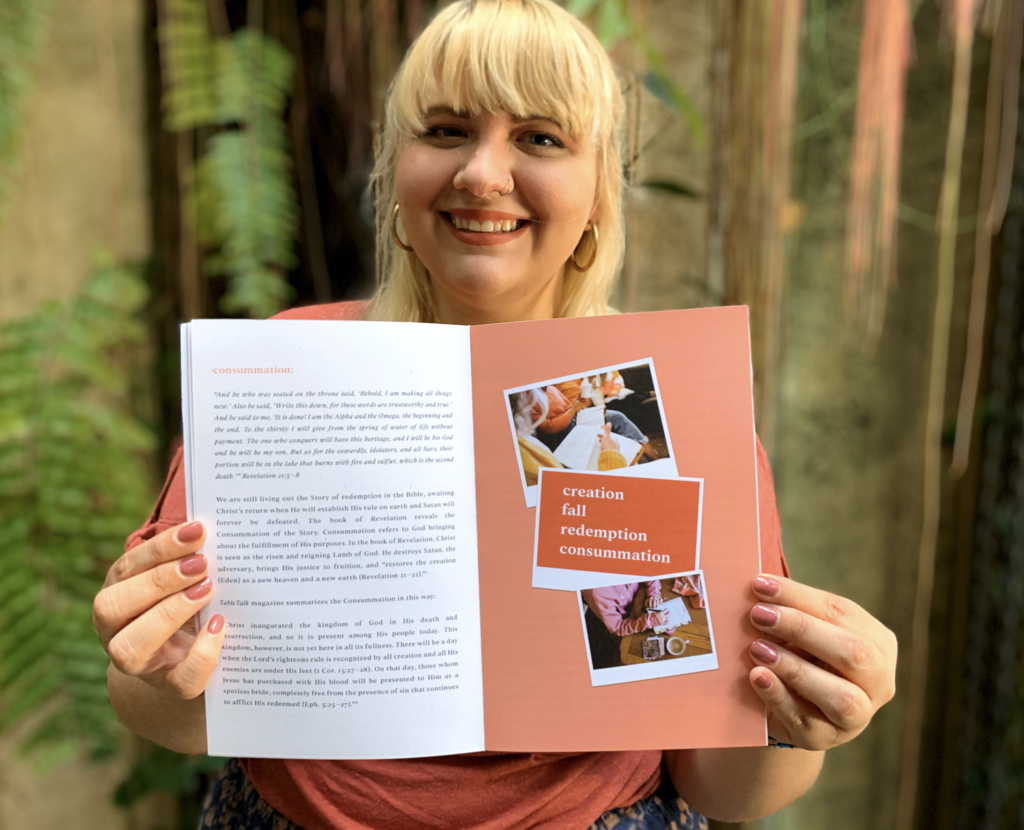
The Book Above Every Other Book
Nearly 130 million books exist so far in this world1, but only one Book has living qualities. Only one has been breathed out by the God of the universe. This book is the Bible.
The Bible is the ageless, unchanging, life-altering Word of God. It is written by human hands, inspired by the Creator of those hands. There is no greater endeavor in life than to know these words in your heart, soul, and mind. In order to know God, you must first know His Word. His Word is the standalone book above all other 130 million books.
But the question remains: how does one study this Book of all books? I grew up hearing about the importance of studying my Bible but was never truly equipped to dig deeper until my college years.
While writing this “How To Study the Bible” guide for Well-Watered Women, I sought to gather helpful, basic tenets for Bible study. I wanted to explain the process of digging deeper in a way that is simple and understandable. Below you will find an excerpt from this guide, explaining how to read the metanarrative of Scripture and study the Word with “Gospel glasses.”
You can find the “How to Study the Bible for the Everyday Woman” guide here, as well as a plethora of Bible study resources!
May we always be students of God’s Word, lovers of the Gospel, and faithful followers of Jesus Christ.
“The message of the Bible is the story of redemption, the divine drama of the creation, fall, and restoration of the people of God. Its purpose is to call people to live in faith, love, and holiness, to submit ourselves to his authority, and to align our lives with his purpose and will.” –Mark Strauss 2
The Structure of the Story
The biblical “metanarrative” (or overarching story of Scripture) is divided into four parts: Creation, Fall, Redemption, and Consummation. As you study Scripture, read the text through this gospel lens and watch for this arc, knowing that the smaller stories are all a part of one larger Story.
Remember that all of Scripture merges into the one larger Story of hope and redemption. These four categories will enable you to understand where you are in the Story and, in turn, be better able to study God’s Word correctly and in context.

Creation:
“In the beginning, God created the heavens and the earth.” Genesis 1:1
“In the beginning was the Word, and the Word was with God, and the Word was God. He was in the beginning with God. All things were made through him and without him was not any thing made that was made.” John 1:1–2
The Bible begins by introducing the main character of the entire Story: God. God is the Creator of all things, the One around whom all things revolve. He is the Sustainer of life, the Author of existence. God created the heavens and the earth from nothing, and then He proceeded to design and invent the rest of the world.
After God created the earth, the heavens, the waters, land, seas, and all animals and birds, He then created man and woman. Mankind was created differently than the rest of creation. Man and woman were created “in His image” to reflect His glory and be in a relationship with Him. The first two chapters of Genesis lay the foundation that the Bible is a story about God and His creation. Though these two chapters of the Bible are brief, they are jam-packed with foundational truth that drives us to worship God, desire to know Him more, and live dependent upon our Creator.
Fall:
“Then the eyes of both were opened, and they knew that they were naked. And they sewed fig leaves together and made themselves loincloths.” Genesis 3:7
“For all have sinned and fall short of the glory of God.” Romans 3:23
In Genesis chapter 3 the Story turns with the first sin and the fall of mankind. As theologian Gordon Fee described, “The dark thread runs through the whole story almost to the very end.”3 The dark thread of sin, however, is not the only thread running throughout the story. More importantly, the hope of the Gospel weaves the rest of the Bible together. It always points mankind to our Creator and the redemption we find in Jesus Christ.
In Genesis 3, Eve first listened to the deceitful lies of the serpent, Satan. She believed that God had withheld good from her and Adam. She desired what God had forbidden—to eat from the tree of the knowledge of good and evil. Her disobedience and longing to be like God did the exact opposite, separating her from God. When Eve and Adam both ate the forbidden fruit their eyes were opened and they realized they were naked. Sin brought about the shame and depravity that every human experiences.
Sons of Disobedience
We learn in Ephesians 2 that all people are born into sin as “sons of disobedience” and “children of wrath” (vs. 1–3). The apostle Paul expanded this even further in Romans 3:23: “For all have sinned and fall short of the glory of God.” All mankind is under the punishment of sin and deserves the just wrath of God for our disobedience.
The fall distorted our desires, rewired our hearts, and separated us from the original unhindered fellowship with God that Adam and Eve experienced in the Garden of Eden. However, though we are dead in our sin, we have incredible, unexplainable, unfathomable hope through Jesus Christ. This hope leads us into the Redemption part of the metanarrative.

Redemption:
“But God shows his love for us in that while we were still sinners, Christ died for us.” Romans 5:8
“For God so loved the world that he gave his only Son, that whoever believes in him should not perish but have eternal life.” John 3:16
Praise God the Story did not end in Genesis 3! While Satan desired to destroy God’s good creation and His people, God had—and always has—a greater plan. When Adam and Eve sinned and were separated from God, He immediately began working out His plan of redemption to set His people free from sin and death. Redemption is God’s miraculous work in saving His people from sin that reigns in our hearts.
“The Bible also tells us that the holy and just God, whose moral perfection burns against sin and creaturely rebellion, is in fact also a God full of mercy and love—and faithfulness.”4 Sin revealed God’s holiness and just wrath, while redemption reveals His grace upon grace. The Redemption part of the metanarrative of Scripture runs from Genesis through Revelation. God’s mercy and grace unfold throughout the Old and New Testaments.
A People Set Apart
In the Old Testament, God called His people and set them apart from the nations, delivering and preserving them. He used men like Abraham, Noah, Moses, and David to establish His covenants and called prophets to draw God’s rebellious people back to Himself and foretell the coming of Christ. He instituted the law and a sacrificial system to atone for sin, which also pointed ahead to the once-and-for-all redemptive sacrifice of Jesus. God’s powerful redemptive work began long before the birth of Jesus, and through the cross of Christ, God completed His work.
The New Testament, also known as the New Covenant, tells the story of God sending His sinless Son, Jesus, to die in our place. Jesus took on the wrath of God for His chosen people so they could be freed from sin’s tyranny to live for Him. The New Testament ties together Christ as the fulfillment of the law of God revealed in the Old Testament. It also shares the establishment of the Church as well as our call today as Christians, the redeemed of God, to follow Him wholeheartedly through dying to ourselves daily and sharing the gospel with the nations.
The Redemption Metanarrative
In summary, Gordon Fee explained the Redemption part of the metanarrative in this way:
“Here is the heart of the story: A loving, redeeming God in his incarnation restored our lost vision of God (took off the wraps, as it were, so that we could plainly see what God is truly like), by his crucifixion and resurrection made possible our being restored to the image of God (See Rom. 8:29; 2 Cor. 3:18), and through the gift of the Spirit became present with us in constant fellowship. Marvelous—well nigh incredible—that revelation, that redemption.”5
Consummation:
“And he who was seated on the throne said, ‘Behold, I am making all things new.’ Also he said, ‘Write this down, for these words are trustworthy and true.’ And he said to me, ‘It is done! I am the Alpha and the Omega, the beginning and the end. To the thirsty I will give from the spring of water of life without payment. The one who conquers will have this heritage, and I will be his God and he will be my son. But as for the cowardly, idolaters, and all liars, their portion will be in the lake that burns with fire and sulfur, which is the second death.’” Revelation 21:5–8
We are still living out the Story of redemption in the Bible, awaiting Christ’s return when He will establish His rule on earth and Satan will forever be defeated. The book of Revelation reveals the Consummation of the Story. Consummation refers to God bringing about the fulfillment of His purposes. In the book of Revelation, Christ is seen as the risen and reigning Lamb of God. He destroys Satan, the adversary, brings His justice to fruition, and “restores the creation (Eden) as a new heaven and a new earth (Revelation 21–22)”.6
The Kingdom and Consummation
TableTalk magazine summarizes the Consummation in this way:
“Christ inaugurated the kingdom of God in His death and resurrection, and so it is present among His people today. This kingdom, however, is not yet here in all its fullness. There will be a day when the Lord’s righteous rule is recognized by all creation and all His enemies are under His feet (1 Cor. 15:27–28). On that day, those whom Jesus has purchased with His blood will be presented to Him as a spotless bride, completely free from the presence of sin that continues to afflict His redeemed (Eph. 5:25–27).”7

For more Bible study resources, visit the Well-Watered Co. Shop, and also see these free resources we have compiled for you! If you want to learn more about how to study the Bible, purchase the new guide here!
[…] that you know what to look for, put on your gospel glasses and grab your highlighters, stickers, and pens. Open your Bible and start taking note of creation, […]